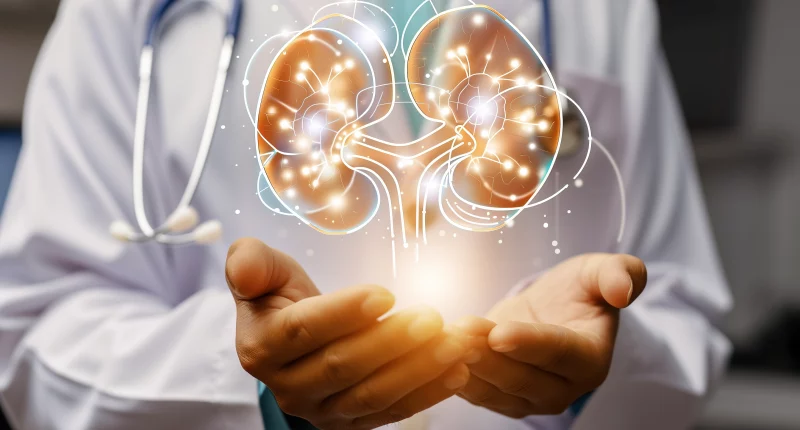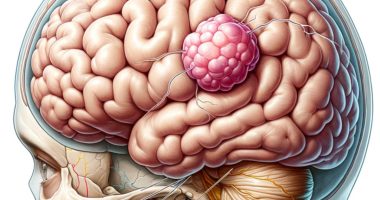Splenomegaly
What’s that?
Splenomegaly is a syndrome characterized by enlargement of the spleen.
About the disease
The spleen belongs to the organs of the abdominal cavity, located on its left side. It participates in developing an immune response to foreign antigens and their removal from the bloodstream, eliminates normal and abnormal blood cells under certain conditions, participates in hematopoiesis, and performs other functions.
Splenomegaly is not an independent disease but a symptom of any pathological process in which the spleen increases in size. Splenomegaly can be the first manifestation of infectious diseases (in particular, infectious mononucleosis), hematological, inflammatory, tumor processes and accumulation diseases (Gaucher’s pathology, amyloidosis), portal hypertension, and splenic vein thrombosis. However, up to 66% of splenomegaly cases are associated with various blood system diseases.
The main examination methods of the spleen are palpation and percussion, ultrasonography, computed tomography (CT), or magnetic resonance imaging (MRI).
Therapeutic tactics are determined by the nature of the pathologic process that led to enlargement of the spleen. Both conservative and surgical management of the clinical case is possible.
Types
Splenomegaly is categorized into two forms depending on the cause of occurrence:
- inflammatory – enlargement of the spleen is a reaction to acute or chronic infections caused by specific and nonspecific pathogens;
- non-inflammatory – due to non-infectious causes (first of all, it is necessary to exclude tumor diseases of the hematopoietic system).
Symptoms of enlarged spleen
There are no pathognomonic symptoms of spleen enlargement. With significant stretching of the organ capsule, a pronounced pain syndrome develops in the left subcostal region. However, this symptom appears in the late stages of the disease. The nature of the background pathology determines clinical signs of splenomegaly.
The following symptoms characterize inflammatory splenomegaly:
- fever of varying severity;
- nausea and vomiting;
- pain in the projection of the primary focus (in intestinal infections – abdominal pain, pneumonia – pain localized in the chest, etc.);
- diarrhea;
- general weakness.
Non-inflammatory enlargement of the spleen may present with the following symptoms:
- left subcostal pain (mild to moderately severe);
- pale skin;
- tendency to bleeding and easy bruising (if hypersplenism joins splenomegaly);
- loss of appetite;
- general weakness.
If splenomegaly is combined with simultaneous enlargement of the liver, and this is possible due to a common blood flow system, then a person is bothered by pain both on the left and right in the subcostal region. The right side can be more pronounced, imitating the pathology of the biliary system.
Causes of enlarged spleen
Causes of spleen enlargement in men and women with consideration of pathogenesis:
- Increase in response to immune stimulation. Such a mechanism is realized in infectious processes and autoimmune pathologies when the immune system “attacks” the body’s tissues.
- Overgrowth of the reticuloendothelial system due to destruction of abnormal blood cells. This situation is seen in hemoblastosis, a tumor of the blood system.
- Increase in the volume of blood flowing through the spleen. It occurs with the growth of connective tissue in the liver and the formation of blood clots in the portal, splenic, or hepatic vein.
- Secondary lesions in malignant diseases. Most often, lymphoma and leukemia metastasize to the spleen.
- Deposition in the spleen of macrophages crowded with fats or other metabolites. A similar mechanism is observed, for example, in Gaucher disease (glucosylceramide accumulates in cells due to a genetic breakdown), amyloidosis (characterized by the formation of pathological amyloid protein), hemochromatosis (a disease in which iron metabolism is disturbed and this substance is deposited in tissues).
- Local pathologic processes in the spleen. These may be cysts, hemangiomas (vascular tumors, etc.).
Thus, enlargement of the spleen can be diffuse or focal.
Diagnosis of splenomegaly
Diagnosis of splenomegaly is aimed at assessing the organ’s structure, identifying possible causes, and determining the functional activity of the spleen.
The following investigations usually represent mandatory examinations in the first stage of the diagnostic search:
- ultrasound scan of the abdominal cavity;
- a CT scan of the abdomen;
- a complete blood count;
- information about body temperature and its possible wave-like rises;
- bilirubin and bilirubin fractions;
- total protein and all protein fractions;
- urinalysis with hemosiderin determination (this allows to exclude hemochromatosis as a possible cause of splenomegaly);
- chest X-ray.
Scintigraphy can be performed to assess the functional capacity of the spleen. This study is based on the ability of the organ’s cells to accumulate isotopes. It also allows the detection of local pathological processes even of small volume.
Treatment of splenomegaly
According to clinical recommendations, the treatment of splenomegaly is determined by the nature of the pathology detected. In some cases, conservative therapy is performed, and surgical intervention is indicated in other cases.
Conservative treatment
Conservative treatment is indicated for inflammatory enlargement of the spleen. The type of inflammation determines the specifics of anti-inflammatory therapy:
- in infectious inflammation, antimicrobial drugs are indicated (antibiotics – in bacterial infection, antiprotozoal agents – in malaria, etc.), and active rehydration to reduce the severity of intoxication syndrome;
- in autoimmune inflammation, corticosteroid drugs are prescribed when the immune system begins to damage the body’s tissues.
If tumors of the blood system (hemoblastosis) are diagnosed, treatment is performed by an oncohematologist. Comprehensive therapy includes cytostatics, radiation therapy, and in severe cases, the issue of bone marrow transplantation is decided (this organ in adults produces blood cells that have become abnormal).
Surgical treatment
Surgical treatment is indicated in case of significant and persistent spleen enlargement (e.g., amyloidosis, thrombosis of the feeding vessels) and combination with hypersplenism. In the latter case, the spleen destroys red blood cells, white blood cells, and platelets, leading to dangerous bleeding and severe infections.
Surgery involves the removal of the spleen. After splenectomy, splenosis may develop about ten years later, characterized by the formation of additional spleen tissue from cells disseminated during surgery. Splenosis is rare and usually asymptomatic but can mimic other pathologic processes. Therefore, when performing ultrasound and detecting unknown volumetric formations in the abdominal cavity, it is important to inform the doctor about the surgery. That will avoid diagnostic errors. Foci of splenosis subsequently require dynamic observation. Removal is indicated in the recurrence of hematologic diseases, as well as in hypersplenism.
All these treatment options are available in more than 400 hospitals worldwide (https://doctor.global/results/diseases/splenomegaly). For example, splenectomy is performed in 12 clinics across Turkey for an approximate price of $6.3 K (https://doctor.global/results/asia/turkey/all-cities/all-specializations/procedures/splenectomy).
Prevention
Prevention is aimed at timely treatment of pathological processes leading to an enlarged spleen. First of all, this applies to infectious and autoimmune diseases.
Rehabilitation
Patients with splenomegaly and after surgery are advised to follow a proper diet:
- give up alcohol;
- eat food prepared by stewing, steaming, or baking;
- give up smoked foods and mushrooms;
- eliminate carbonated beverages;
- include vegetables, fruits, and herbs in your diet;
- replace fatty meats with lean meats and fish.



